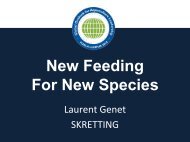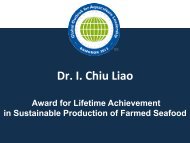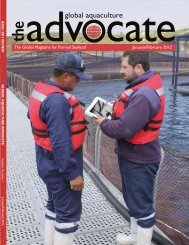May/June 2010 - Global Aquaculture Alliance
May/June 2010 - Global Aquaculture Alliance
May/June 2010 - Global Aquaculture Alliance
You also want an ePaper? Increase the reach of your titles
YUMPU automatically turns print PDFs into web optimized ePapers that Google loves.
innovation<br />
Life Cycle Assessment In <strong>Aquaculture</strong><br />
‘Not A Single Event, But A Combination Of Processes’<br />
Life cycle assessment considers product inputs and impacts from raw materials to disposal.<br />
Processing and packaging are involved, as well as transportation for distribution.<br />
Summary:<br />
Life cycle assessment studies the<br />
environmental and other potential<br />
impacts throughout a product’s<br />
life, starting at raw material<br />
and following it through production,<br />
use and disposal. LCA can<br />
help identify ways to mitigate<br />
environmental impacts and generate<br />
cost savings. LCA can also<br />
assist in risk management and<br />
support purchasing, design and<br />
waste management decisions for<br />
companies.<br />
The food industry is likely to come<br />
under greater scrutiny over coming years<br />
as world population rises put pressure on<br />
food stocks and prices with inevitable<br />
strain on the environment. There is also<br />
significant pressure on energy resources,<br />
in which the production of food using<br />
carbon-intensive fuels is linked to accelerating<br />
global climate change.<br />
The policies of governments and nongovernmental<br />
organizations on food are<br />
therefore moving to a more holistic<br />
approach of environmental impact assessment,<br />
of which life cycle assessment<br />
(LCA) is a part. LCA is also becoming<br />
more important in the world of corporate<br />
social responsibility, for consumers<br />
increasingly consider sustainability as<br />
they make seafood purchases.<br />
Life Cycle Assessment<br />
Life cycle assessment studies the environmental<br />
and other potential impacts of<br />
a product throughout its life, starting at<br />
raw material and following it through<br />
production, use and disposal. LCA can<br />
also be used to assess the environmental<br />
impacts of a process or service from<br />
design to disposal, across the entire life<br />
cycle.<br />
The general categories of environmental<br />
impacts considered include<br />
resources used and ecological consequences.<br />
Governed by the ISO 14040<br />
and 14044 standards, LCA requires the<br />
gathering and appraisal of data on the<br />
inputs and outputs of material, energy<br />
and waste flows of a product.<br />
LCA consists of four complementary<br />
elements:<br />
• Goal definition and scoping. This<br />
includes a full description of the<br />
product, process or activity. Why<br />
the assessment is required should be<br />
established, as well as the boundaries<br />
and environmental effects to be<br />
identified and reviewed.<br />
• Inventory analysis. Energy, water<br />
and materials usage and environ-<br />
William Davies<br />
Humber Seafood Institute<br />
Grimsby Institute of Further<br />
and Higher Education<br />
Grimsby DN37 9TZ<br />
United Kingdom<br />
daviesw@grimsby.ac.uk<br />
mental releases need to be determined.<br />
• Impact assessment. This is examination<br />
of potential human impacts, the<br />
effects of energy, water and material<br />
usage, and the environmental<br />
releases identified in the inventory<br />
analysis.<br />
• Interpretation. The evaluation of the<br />
results from the inventory analysis<br />
assessment is tailored to the product,<br />
process or service. It must reflect<br />
clear understanding of the boundaries<br />
and assumptions used to generate<br />
the results.<br />
LCA can help identify ways to mitigate<br />
environmental impacts and generate<br />
cost savings. It can also be used for assess-<br />
ing risks to improve systems, such as in<br />
risk management. In addition, LCA can<br />
support decision making for companies,<br />
such as purchasing, product design, process<br />
selection and waste management<br />
strategies.<br />
Stages Of LCA<br />
The use of energy at different stages<br />
during production requires an assessment<br />
of the overall impact on the environment.<br />
This is not dependent on a single event,<br />
but a combination of all the processes.<br />
LCA considers inputs from the raw<br />
material extractions until disposal. During<br />
the transformation, manufacturing<br />
and packaging are involved, as well as<br />
transportation for distribution.<br />
For the entire life cycle in the production<br />
of food, the agricultural inputs are<br />
the seeds, fertilizers and water. The produce<br />
is then harvested and transported to<br />
factories for processing. Energy use is<br />
associated with this process, and fossil<br />
fuel inputs release greenhouse gases during<br />
cultivation, conversion and distribution,<br />
hence contributing to the environ-<br />
mental footprint. The results of operating<br />
procedures need to be compared to other<br />
standards to establish the impacts on the<br />
environment.<br />
<strong>Aquaculture</strong> Assessment<br />
In aquaculture, feed is the most significant<br />
input, but larvae or fingerlings,<br />
fuel and occasional medicinal treatments<br />
are also required. These key inputs are<br />
being measured more closely than in the<br />
past and are even published in annual<br />
corporate sustainability reports.<br />
A primary measurement related to the<br />
productivity of feed is the feed-conversion<br />
ratio (FCR). The FCR measures the<br />
volume of feed input against the weight<br />
of harvested seafood. Salmon production<br />
has rather low FCRs, making it competitive<br />
in feed use against other proteins and<br />
less affected by high feed prices than pork<br />
or beef farming. On the basis of fish protein,<br />
current salmon production techniques<br />
can achieve FCR values below 1,<br />
making the industry a net provider of fish<br />
protein to the human diet.<br />
Advances in feed technology continually<br />
lower the environmental footprint of<br />
salmon farming, both as a user of wild<br />
fish in feed and in carbon emissions.<br />
Shrimp feed needs high protein content<br />
as well as lipids, fiber and other essential<br />
nutrients. A wide variety of ingredients,<br />
from algae to poultry trimmings, are<br />
being investigated as replacements for the<br />
traditional fishmeal protein base in<br />
shrimp diets.<br />
Low-Impact Species<br />
Of worthy mention due to their low<br />
impacts on carbon emissions during<br />
aquaculture are tilapia, carp, oysters and<br />
mussels (Table 1). Tilapia and carp can<br />
both be grown in aquaponics with horticulture,<br />
living in recirculation systems<br />
with very little feed inputs needed, as the<br />
plants and fish feed off each others’<br />
waste. Seen as a promising sustainable<br />
food production method for the future,<br />
this approach is also known as integrated<br />
multitrophic aquaculture.<br />
FCRs in carp culture are commonly as<br />
low as 0.3. Fishmeal ratios are on a downward<br />
trend, and from a fish sustainability<br />
stance, can be 1 in fish in:fish out ratios.<br />
Fishing makes up a major part of the<br />
aquaculture fishmeal supply, with wildcapture<br />
marine protein added to feed, as<br />
well as trimmings from fish processing.<br />
Mollusks such as oysters and mussels<br />
are grown with only natural feed inputs<br />
from the nutrients in the water in which<br />
they are raised. This means their feed<br />
<strong>Aquaculture</strong> Nutrition<br />
Guabi is producing tomorrow´s aquafeed<br />
Cost effective for both marine and freshwater farming,<br />
floating, slow sinking or sinking,<br />
specialties,<br />
based on scientific formulation to meet requirements of fish and shrimp<br />
that leads to profitable and environmentally responsible farming.<br />
Visit us at www.guabi.com<br />
Feed for fish and shrimp<br />
Animal Nutrition<br />
72 <strong>May</strong>/<strong>June</strong> <strong>2010</strong> global aquaculture advocate global aquaculture advocate <strong>May</strong>/<strong>June</strong> <strong>2010</strong> 73





